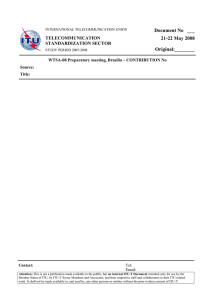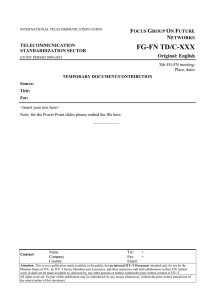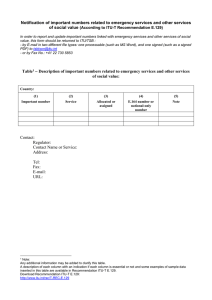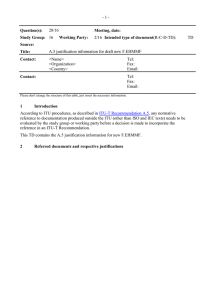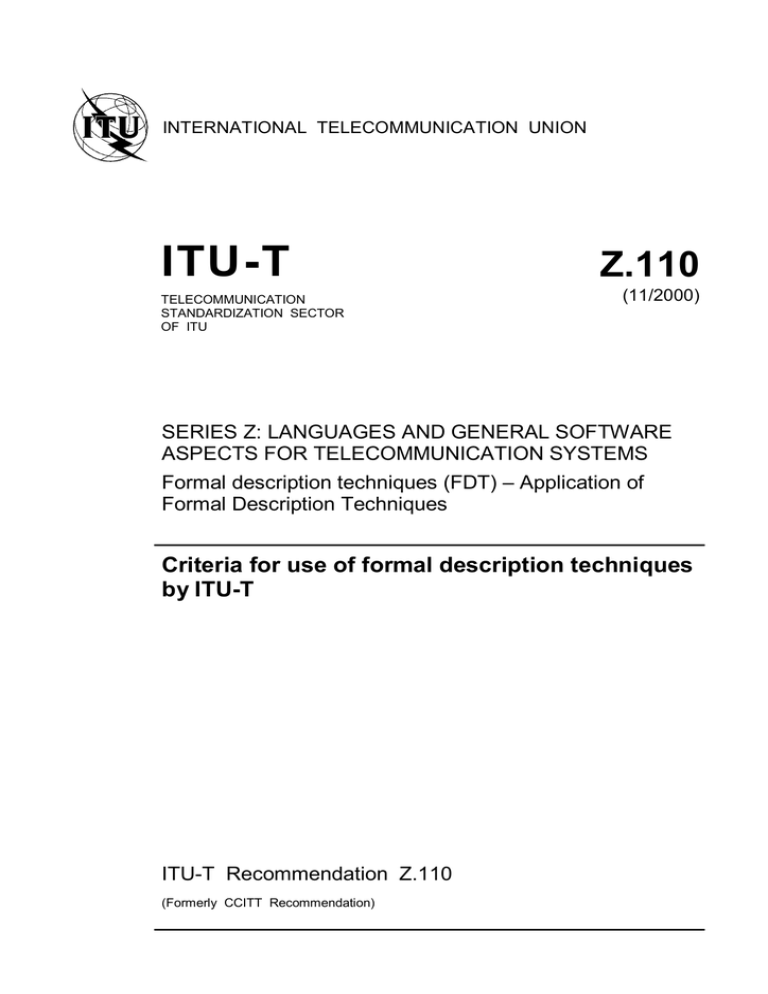
INTERNATIONAL TELECOMMUNICATION UNION
ITU-T
TELECOMMUNICATION
STANDARDIZATION SECTOR
OF ITU
Z.110
(11/2000)
SERIES Z: LANGUAGES AND GENERAL SOFTWARE
ASPECTS FOR TELECOMMUNICATION SYSTEMS
Formal description techniques (FDT) – Application of
Formal Description Techniques
Criteria for use of formal description techniques
by ITU-T
ITU-T Recommendation Z.110
(Formerly CCITT Recommendation)
ITU-T Z-SERIES RECOMMENDATIONS
LANGUAGES AND GENERAL SOFTWARE ASPECTS FOR TELECOMMUNICATION SYSTEMS
FORMAL DESCRIPTION TECHNIQUES (FDT)
Specification and Description Language (SDL)
Application of Formal Description Techniques
Message Sequence Chart
PROGRAMMING LANGUAGES
CHILL: The ITU-T programming language
MAN-MACHINE LANGUAGE
General principles
Basic syntax and dialogue procedures
Extended MML for visual display terminals
Specification of the man-machine interface
QUALITY OF TELECOMMUNICATION SOFTWARE
METHODS FOR VALIDATION AND TESTING
For further details, please refer to the list of ITU-T Recommendations.
Z.100–Z.109
Z.110–Z.119
Z.120–Z.129
Z.200–Z.209
Z.300–Z.309
Z.310–Z.319
Z.320–Z.329
Z.330–Z.399
Z.400–Z.499
Z.500–Z.599
ITU-T Recommendation Z.110
Criteria for use of formal description techniques by ITU-T
Summary
In view of the complexity and widespread use of Recommendations, it is imperative that adequate
and appropriate description techniques and languages be used to ensure the required quality levels
of Recommendations.
The purpose of this Recommendation is to guide the use of Description Techniques to ensure the
quality of ITU-T Recommendations. Where special requirements for verification and validation
exist, Formal Description Techniques (FDTs) should be used.
The effective use of FDTs requires phased procedures to introduce their use. This Recommendation
states the procedures to accomplish this task.
Effective use of FDTs implies the use of state-of-the-art tools.
Supplement 1 to ITU-T A-series Recommendations (09/98) – Guidelines on quality aspects of
protocol related Recommendations – states: "Guidelines on the use of FDTs are contained in
Recommendation Z.110. It provides criteria for their use and should, therefore, be taken as a
reference in conjunction with this Supplement. It is planned to extend the scope of Recommendation
Z.110 to cover a wider range of applications developed by groups such as the OMG."
Resolution 4 on Conformity Assessment and Quality of Standards from the Joint Meeting of Global
Standards Collaboration-5/RAST, Williamsburg, USA, 23-26 August 1999, concludes:
a)
"that the use of protocol specifications expressed in SDL in conjunction with the available
SDL-based commercial software tools will in the end produce higher quality
Recommendations;
b)
that approval of protocol Recommendations expressed in SDL will be achieved in a shorter
time than approval of Recommendations written in natural language.
and resolves:
1)
2)
to encourage ITU-T Study Groups to apply Supplement 1 to A-series Recommendations,
Guidelines on the Quality Aspects of Protocol Related Recommendations, when developing
new protocol related recommendations;
to encourage ITU to provide editing and technical support for the development and
maintenance of complex Recommendations;
3)
to encourage companies that participate in GSC member organizations to make use of
commercial SDL/TTCN tools in their reviews of draft Recommendations;
4)
to encourage companies that participate in GSC member organizations to assist in the
establishment of facilities for training in the use of formalized methodology and tools; and
ITU-T Z.110 (11/2000)
i
5)
to encourage GSC member organizations to participate in the development of the
methodologies that they use in their standardization processes."
It should be noted that the ITU-T Description Techniques are not restricted to specification of
protocols, but are applicable to a much larger application area.
Source
ITU-T Recommendation Z.110 was revised by ITU-T Study Group 10 (2001-2004) and approved
under the WTSA Resolution 1 procedure on 24 November 2000.
ii
ITU-T Z.110 (11/2000)
FOREWORD
The International Telecommunication Union (ITU) is the United Nations specialized agency in the field of
telecommunications. The ITU Telecommunication Standardization Sector (ITU-T) is a permanent organ of
ITU. ITU-T is responsible for studying technical, operating and tariff questions and issuing Recommendations
on them with a view to standardizing telecommunications on a worldwide basis.
The World Telecommunication Standardization Assembly (WTSA), which meets every four years,
establishes the topics for study by the ITU-T study groups which, in turn, produce Recommendations on these
topics.
The approval of ITU-T Recommendations is covered by the procedure laid down in WTSA Resolution 1.
In some areas of information technology which fall within ITU-T's purview, the necessary standards are
prepared on a collaborative basis with ISO and IEC.
NOTE
In this Recommendation, the expression "Administration" is used for conciseness to indicate both a
telecommunication administration and a recognized operating agency.
INTELLECTUAL PROPERTY RIGHTS
ITU draws attention to the possibility that the practice or implementation of this Recommendation may
involve the use of a claimed Intellectual Property Right. ITU takes no position concerning the evidence,
validity or applicability of claimed Intellectual Property Rights, whether asserted by ITU members or others
outside of the Recommendation development process.
As of the date of approval of this Recommendation, ITU had not received notice of intellectual property,
protected by patents, which may be required to implement this Recommendation. However, implementors are
cautioned that this may not represent the latest information and are therefore strongly urged to consult the
TSB patent database.
ITU 2001
All rights reserved. No part of this publication may be reproduced or utilized in any form or by any means,
electronic or mechanical, including photocopying and microfilm, without permission in writing from ITU.
ITU-T Z.110 (11/2000)
iii
CONTENTS
Page
1
Scope .....................................................................................................................
1
2
References..............................................................................................................
1
3
Terms and definitions .............................................................................................
1
3.1
Definitions..............................................................................................................
1
3.2
Abbreviations .........................................................................................................
2
4
FDTs ......................................................................................................................
2
4.1
Objectives of an FDT .............................................................................................
2
4.2
Benefits of a description technique .........................................................................
2
4.3
Use of description techniques .................................................................................
3
4.4
Support for description techniques..........................................................................
3
4.5
Criteria for the use description techniques ..............................................................
3
5
Criteria for development and Recommendation of description techniques...............
3
6
Procedure for development of formal definitions ....................................................
4
iv
ITU-T Z.110 (11/2000)
ITU-T Recommendation Z.110
Criteria for use of formal description techniques1 by ITU-T
1
Scope
This Recommendation applies to the use of Description Techniques in ITU-T Recommendations.
Description Techniques are intended to be used in the development, specification, implementation
and verification of Recommendations (or parts thereof).
2
References
The following ITU-T Recommendations and other references contain provisions which, through
reference in this text, constitute provisions of this Recommendation. At the time of publication the
editions indicated were valid. All Recommendations and other references are subject to revision;
users of this Recommendation are therefore encouraged to investigate the possibility of applying the
most recent edition of the Recommendations and other references listed below. A list of the currently
valid ITU-T Recommendations is regularly published.
–
ITU-T X.292 (1998), OSI conformance testing methodology and framework for protocol
Recommendations for ITU-T applications – The Tree and Tabular Combined Notation
(TTCN).
–
ITU-T X.680 (1997) | ISO/IEC 8824-1:1998, Information technology – Abstract Syntax
Notation One (ASN.1): Specification of basic notation.
–
ITU-T X.722 (1992) | ISO/IEC 10165-4:1992, Information technology – Open Systems
Interconnection – Structure of management information: Guidelines for the definition of
managed objects.
–
ITU-T X.920 (1997) | ISO/IEC 14750:1999, Information technology – Open distributed
processing – Interface Definition Language (IDL).
–
–
–
–
–
–
–
ITU-T Z.100 (1999), Specification and Description Language (SDL).
ITU-T Z.105 (1999), SDL combined with ASN.1 modules (SDL/ASN.1).
ITU-T Z.107 (1999), SDL with embedded ASN.1.
ITU-T Z.109 (1999), SDL combined with UML.
ITU-T Z.120 (1999), Message Sequence Chart (MSC).
ITU-T Z.130 (1999) ITU object definition language.
UML (OMG).
3
Terms and definitions
3.1
Definitions
This Recommandation defines the following terms:
____________________
1
The content of the previous version of this Recommendation was also published as ISO Resolution
ISO/IEC JTC 1/N 145.
The statement on precedence in case of several descriptions contained in the JTC 1 document is omitted in
this Recommendation.
ITU-T Z.110 (11/2000)
1
3.1.1 formal definition: Part of a Recommendation based on the use of a formal description
technique.
3.1.2 formal description technique: A specification technique based on a technical language
using rigorous and unambiguous rules both with respect to developing expressions in the language
(formal syntax) and interpreting the meaning of these expressions (formal semantics). The main
FDTs recommended by ITU-T are ASN.1 (ITU-T X.680), TTCN (ITU-T X.292 and Z.140), GDMO
(ITU-T X.722), SDL (ITU-T Z.100), MSC (ITU-T Z.120), SDL with ASN.1 (ITU-T Z.105), SDL
combined with UML (ITU-T Z.109) and ODL (ITU.T Z.130).
3.1.3 natural language description: An example of an informal description technique using one
of the languages used by ITU-T to publish Recommendations. It may be supplemented with
mathematical and other accepted notation, figures, etc.
3.2
Abbreviations
This Recommendation uses the following abbreviations:
EDH
Electronic Document Handling
FD
Formal Definition
FDT
Formal Description Technique
4
FDTs
4.1
Objectives of an FDT
The goal of an FDT is to permit precise and unambiguous specifications. FDTs are also intended to
satisfy objectives such as:
–
a basis for analysing specifications for correctness, efficiency, etc. (by simulation,
verification or systematic test derivation);
–
a basis for determining completeness of specifications;
–
a basis for validation of specifications against the requirement of the Recommendation;
–
a basis for determining conformance of implementations to Recommendations;
–
a basis for determining consistency of specifications between Recommendations;
–
a basis for implementation support.
In some areas more than one Description Techniques may be needed to accomplish all objectives.
If only ITU-T is involved, then only Description Techniques Recommended by ITU-T shall be used.
If for any reason other techniques are used, the rationale for not using existing ITU Description
Techniques shall be provided. This restriction may not apply if the standard is being developed in
collaboration with other standards organizations.
4.2
Benefits of a description technique
The application of a description technique can provide benefits such as:
–
improving the quality of Recommendations, which in turn reduces maintenance costs to both
ITU-T and to users of Recommendations;
–
reducing dependency on the natural language to communicate technical concepts in a
multilingual environment;
–
supporting the validation of Recommendations and the easier generation of conformance
tests for Recommendations, which then makes it easier to test products;
2
ITU-T Z.110 (11/2000)
–
–
reducing development time of implementations by using tools that are based on the
properties of the Description Techniques;
making the implementation easier, resulting in better products.
4.3
Use of description techniques
Description Techniques are advanced techniques which are widely used in industry. Significant
investment in training and tools have been made by ITU-T members.
There are limited resources for the development (rather than use) of Description Techniques. The
development of Description Techniques tends to be a lengthy and costly task.
Although there is expertise within the ITU-T Study Groups both to assess the technical merits of the
formally described Recommendations and to reach consensus on them, this is also limited.
4.4
Support for description techniques
The development and availability of tutorial and educational materials helps to provide widespread
understanding of the complexities and capabilities of Description Techniques. The benefits of using
Description Techniques can only be assured after some training.
Tools to support a Description Technique that is used in a Recommendation is an important facility
that can ensure that many defects in draft Recommendations can be removed before they are
published, and that the Description Technique is used with the semantics defined in the FDT
Recommendation. The use of EDH enables ITU-T members to analyse draft Recommendations y
clause be utilize approved Recommendations in their own preferred FDT tools.
4.5
Criteria for the use description techniques
The description techniques used within a Recommendation shall be decided by the Study Group
responsible for the Recommendation taking the factors in 4.1, 4.2, 4.3, 4.4 and 4.5 and the procedure
in clause 6. The primary criteria for the decision shall be the technical quality of the
Recommendation. As a consequence the description techniques in 3.1.2 should normally be used for
those parts of a Recommendation that can be described in this way.
In some cases other criteria such as existing documentation and urgent market need are sufficient to
justify an alternative description approach. Where a Recommendation could use one of techniques
described in 3.1.2, but a different technique or just natural language is used, the Recommendation
should include the rationale for the choice taken.
5
Criteria for development and Recommendation of description techniques
It is important to avoid unnecessary proliferation of Description Techniques, because of the cost and
difficulty of supporting many Description Techniques both for ITU-T and for its members. The
following criteria shall be met before adopting a new Description Technique for use in ITU-T
Recommendations:
–
the need for the Description Technique shall be demonstrated;
–
–
–
evidence that it is based on a significantly different model from that of an existing
Description Technique shall be provided;
the usefulness and capabilities of the Description Technique shall be demonstrated;
there shall be at least two tools that adequately support the Description Technique available
to any party on fair and reasonable terms.
When a significant modification to an existing Description Technique is considered, this shall be
treated in basically the same way as a new Description Technique, regardless of whether the change
ITU-T Z.110 (11/2000)
3
is backwards compatible or not. The objectives are to keep both the number of Description
Techniques low and each Description Technique itself stable to the benefit of all parties.
Any adoptions of new Description Techniques or modifications of existing Description Techniques
should be communicated to the Lead Study Group for Description Techniques.
6
Procedure for development of formal definitions
6.1
Only standard FDTs (or FDTs in the process of being standardized) shall be used in Formal
Definitions (FDs) of Recommendations.
6.2
The adoption of a Description Technique for any particular Recommendation is a decision
of the Study Group (in consultation with involved standardization organizations for collaborative
standards). If a FD is to be developed for a new Recommendation, the FD shall be progressed at
least as fast as the Recommendation.
6.3
For the evolutionary introduction of FDs into Recommendations, three phases can be
identified. It is the responsibility of the Study Group to decide which phase initially applies to each
FD and the possible evolution of the FD toward another phase. It is not mandatory for a FD to go
through the three phases described below and, more generally, it is not mandatory for a FD to
evolve.
Phase 1
This phase is characterized by the fact that widespread knowledge of Description Techniques and
experience in FDs are lacking; there may not be sufficient resources in the Study Groups to produce
or review FDs.
The development of Recommendations has to be based on conventional natural language
approaches, leading to Recommendations where the natural language description is the definitive
Recommendation.
Study Groups are encouraged to develop FDs of their Recommendations since these efforts will
contribute to the quality of the Recommendations by detecting defects, may provide additional
understanding to readers, and will support the evolutionary introduction of FDTs.
A FD produced by a Study Group that can be considered to represent faithfully a significant part of
the Recommendation or the complete Recommendation should be published as an appendix to the
Recommendation.
Meanwhile Study Groups should develop and provide educational material for the Description
Techniques to support their widespread introduction in the ITU-T and Liaison Organizations.
Phase 2
This phase is characterized by the fact that knowledge of Description Techniques and experience in
FDs are more widely available; Study Groups can provide enough resources to support the
production of FDs. However, it cannot be assured that enough ITU-T Members can review FDs in
order to enable them to approve a proposed formally defined Recommendation.
The development of Recommendations should still be based on conventional natural language
approaches, leading to Recommendations where the natural language description is the definitive
standard. However, these developments should be accompanied and supported by the development
of FDs of these Recommendations with the objective of improving and supporting the structure,
consistency, and correctness of the natural language description.
A FD, produced by a Study Group, that is considered to represent faithfully a significant part of the
Recommendation or the complete Recommendation should be published as an Annex to the
Recommendation.
4
ITU-T Z.110 (11/2000)
Meanwhile educational work should continue.
Phase 3
This phase is characterized by the fact that a widespread knowledge of FDTs may be assumed;
ITU-T Members can provide sufficient resources both to produce and review FDs, and assurance
exists that the application of FDTs does not unnecessarily restrict freedom of the implementations.
Study Groups should use FDTs routinely to develop their Recommendations, and the FD(s) become
part of the Recommendation together with natural language descriptions.
Whenever a discrepancy between a natural language description and a FD, or between two FDs, is
detected, the discrepancy should be resolved by changing or improving the natural language
description or the FDs without necessarily giving preference to one over the other(s). Any
inconsistency between any two parts of a Recommendation (regardless of whether either part uses an
FD or not) means that there is an error in the Recommendation that needs to be corrected.
6.4
The above procedures for phased development of FDs are intended to aid the progression of
FDs within the standards process, not to hinder their progression. Should procedural problems arise,
the Lead Study Group for Description Techniques should be informed and, where possible,
recommended procedural modifications should be proposed to alleviate the problems.
ITU-T Z.110 (11/2000)
5
SERIES OF ITU-T RECOMMENDATIONS
Series A
Organization of the work of ITU-T
Series B
Means of expression: definitions, symbols, classification
Series C
General telecommunication statistics
Series D
General tariff principles
Series E
Overall network operation, telephone service, service operation and human factors
Series F
Non-telephone telecommunication services
Series G
Transmission systems and media, digital systems and networks
Series H
Audiovisual and multimedia systems
Series I
Integrated services digital network
Series J
Cable networks and transmission of television, sound programme and other multimedia signals
Series K
Protection against interference
Series L
Construction, installation and protection of cables and other elements of outside plant
Series M
TMN and network maintenance: international transmission systems, telephone circuits,
telegraphy, facsimile and leased circuits
Series N
Maintenance: international sound programme and television transmission circuits
Series O
Specifications of measuring equipment
Series P
Telephone transmission quality, telephone installations, local line networks
Series Q
Switching and signalling
Series R
Telegraph transmission
Series S
Telegraph services terminal equipment
Series T
Terminals for telematic services
Series U
Telegraph switching
Series V
Data communication over the telephone network
Series X
Data networks and open system communications
Series Y
Global information infrastructure and Internet protocol aspects
Series Z
Languages and general software aspects for telecommunication systems
Geneva, 2001

